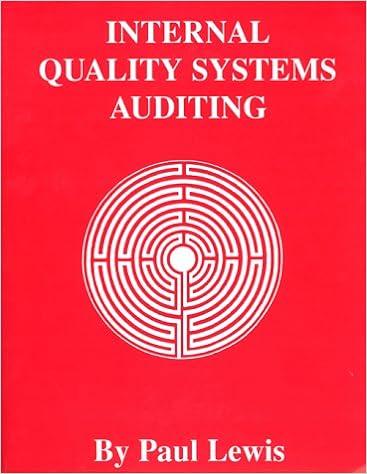Question
The Leisure Products Company manufactures lawn and patio furniture. Most of its output is sold to do-it-yourself warehouse stores (e.g., Lowes Home Improvement) and to
The Leisure Products Company manufactures lawn and patio furniture. Most of its output is sold to do-it-yourself warehouse stores (e.g., Lowes Home Improvement) and to retail hardware and department store chains (e.g., True Value and JCPenney), who then distribute the products under their respective brand names. LP is not involved in direct retail sales. Last year the firm had sales of $35 million. One of LPs divisions manufacturers folding (aluminum and vinyl) chairs. Sales of the chairs are highly seasonal, with 80% of the sales volume concentrated in the January June period. Production is normally concentrated in the September May period. Approximately 75 percent of the hourly workforce (unskilled and semiskilled workers) is laid off (or takes paid vacation time) during the June- August period of reduced output. The remainder of the workforce, consisting of salaries plant management (line managers and supervisors), maintenance, and clerical staff, are retained during this slow period. Maintenance personnel, for example perform major overhauls of the machinery during the slow summer period. LP planned to produce and sell 500,000 of these chairs during the coming year at a projected selling price of $7.15 per chair. The cost per unit was estimated as follows: . . Direct Labor $2.25 MATERIALS $2.30 PLANT OVERHEAD* 1.15 Administrative & selling expense* 0.80 Total $6.50 *these costs are allocated to each unit of output based o the projected annual production of 500,000 chairs. . > A 10 percent markup (%0.65) was added to the cost per unit in arriving at the firms selling price of $7.15 (plus shipping). In May, LP received an inquiry from Southeast Department Stores concerning the possible purchase of folding chairs for delivery in August. Southeast indicated that they would place an order of 30,000 chairs if the price did not exceed $5.50 each (plus shipping). The chairs could be produced during slow period using the firms existing equipment workforce. No overtime wages would have to be paid to the workforce in fulfilling the order. Adequate materials were on hand (or could be purchased at prevailing market prices) to complete the order. LP management was considering whether to accept the order. The firms chief accountant felt that the firm should not accept the order because the price per chair was less than the total cost and contributed nothing to the firms profits. The firms chief economist argued that the firm should accept the order if the incremental revenue would exceed the incremental cost. The following cost accounting definitions may be helpful in making this decision: Direct labor: Labor cost incurred in converting the raw material into the finished product. Direct labor costs consist of gross wages paid to those who physically and directly work on the goods being produced. For example, wages paid to a welder in a bicycle factory who is actually fabricating the frames of bicycles would be included in direct labor. On the other hand, the wages paid to a welder who is building an assembly line that will be used to produce a new line of bicycles is not direct labor. In general, indirect labor pertains to wages of other factory employees (e.g., maintenance personnel, supervisors, guards, etc.) who do not work directly on a product. Indirect labor is rolled into manufacturing overhead. Material: Raw materials that enter into and become part of the final product. Plant overhead: All costs other than direct labor and materials that are associated with the product, including wages and salaries paid to employees who do not work directly on the product but whose services are related to the production process (line managers, maintenance, and janitorial personnel); heat; light; power; supplies; depreciation; taxes; and insurance on the assets employed in the production process. Manufacturing overhead includes all costs of manufacturing other than direct materials and direct labor. Examples include indirect materials, indirect labor, and factory related depreciation, repair, insurance, maintenance, utilities, property taxes, and so forth. Factory overhead is also known as indirect manufacturing cost, burden, or other synonymous terms. Factory overhead is difficult to trace to specific finished units, but its cost is important and must be allocated to those units. Normally, this allocation is applied to ongoing production based on estimated allocation rates, with subsequent adjustment processes for over- or under-applied overhead. This is quite important to product costing, and will be covered in depth later. Selling and distribution cost: Costs incurred in making sales (e.g., billing and salespeoples compensation), storing the product, and shipping the product to the customer. (In this case the customer pays all shipping costs.) Administrative costs: Items not listed in the preceding categories, including general and executive office costs, research, development, engineering costs, and miscellaneous items. Administrative costs arise from general management of the business, including items like executive salaries, accounting departments, public and human relations, and the like. Questions: Calculate the incremental, or marginal, cost per chair to Leisure Products of accepting the order from Southeast? 2. What assumptions did you make in calculating the incremental cost in Question 1?all salaries were already calculated and paid regardless of productions on company expenses sheet, and the material is on hand. What additional information would be helpful in making these calculations? Knowing the salary of managers.if they have on hand take out 2.20 (2.25) 3. Based on your answers to Questions 1 and 2, should Leisure Products accept the Southeast order? 4. What additional considerations might lead Leisure Products to reject the order?
Step by Step Solution
There are 3 Steps involved in it
Step: 1

Get Instant Access to Expert-Tailored Solutions
See step-by-step solutions with expert insights and AI powered tools for academic success
Step: 2

Step: 3

Ace Your Homework with AI
Get the answers you need in no time with our AI-driven, step-by-step assistance
Get Started


